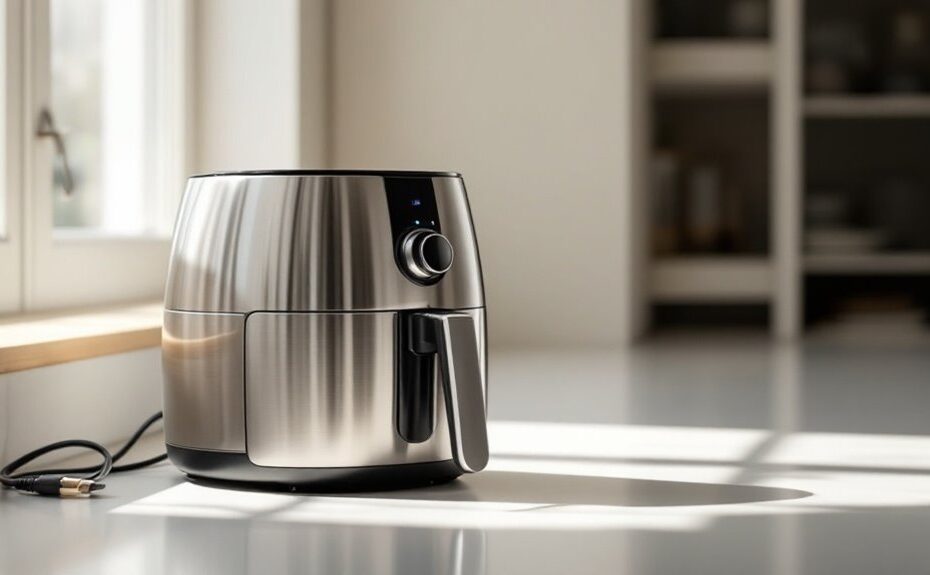Storing your air fryer properly guarantees it stays in top condition and lasts longer. You'll want to unplug it, let it cool, and clean it thoroughly before putting it away. But where should you store it, and how can you protect it from dust or damage? Should you keep it on the counter or tuck it into a cabinet? The answers depend on your space and how often you use it. There's more to think about, like ventilation and the best way to organize accessories. What steps can you take to make storage simple and effective? Let's explore the details.
Key Takeaways
- Unplug the air fryer and let it cool completely for 30-60 minutes before storing to prevent burns and damage.
- Clean all removable parts with warm, soapy water and ensure they are fully dry to avoid mold or rust.
- Store in a cool, dry, and well-ventilated area away from heat sources, sunlight, or damp conditions.
- Use the original packaging or a protective cover to shield the air fryer from scratches, dust, and moisture.
- Avoid stacking heavy items on top and ensure adequate airflow around the unit to maintain its condition and performance.
Unplug the Air Fryer After Use
After you've finished using your air fryer, always unplug it from the power outlet to secure safety and prevent energy consumption. Leaving it plugged in can lead to unnecessary energy usage, reducing its energy efficiency over time. Unplugging also minimizes the risk of electrical hazards, such as short circuits or overheating, which are critical safety precautions to follow. Make it a habit to disconnect the appliance immediately after use, even if you plan to clean or store it later. This simple step guarantees the air fryer isn't drawing power when idle and protects it from potential damage. By prioritizing these practices, you'll extend the lifespan of your appliance while maintaining a safe kitchen environment. Always double-check that it's unplugged before moving or storing it.
Allow the Air Fryer to Cool Completely
Before storing your air fryer, let it cool completely to avoid trapping heat and moisture inside. This prevents potential damage to the appliance and guarantees it's safe to handle. Don't rush the process—give it at least 30 minutes to cool down fully.
Ensure Proper Cooling Time
Once you've finished using your air fryer, let it cool completely before storing it to prevent damage or accidents. The cooling duration typically takes 30-60 minutes, depending on usage and model. Avoid touching the appliance or its components during this time, as they remain hot. Monitor the temperature by checking the exterior and interior surfaces before handling. Placing a hot air fryer in storage can warp materials, damage internal components, or create a fire hazard. Make sure the basket, tray, and other removable parts are also cooled before cleaning or storing. Proper cooling not only extends the lifespan of your air fryer but also guarantees safety when handling or moving it. Always prioritize patience over convenience to maintain your appliance's functionality and safety.
Avoid Immediate Storage
Letting your air fryer cool completely before storing it is a key step in maintaining its condition and guaranteeing safety. Avoid immediate storage after use, as residual heat can trap moisture inside, leading to potential damage or mold growth. Always unplug the appliance and let it sit for at least 30 minutes to prevent overheating and guarantee all components cool down evenly. Wipe the exterior and interior surfaces to avoid moisture buildup, which can harm electrical parts. Storing a hot air fryer can also warp its materials or cause burns if handled carelessly. By allowing it to cool, you'll extend its lifespan and keep it in peak working condition. Patience here pays off in both safety and performance.
Clean the Air Fryer Thoroughly
Start by removing any food residue from the basket and tray using warm, soapy water or a non-abrasive sponge. Wipe down the exterior with a damp cloth to remove grease or dust, ensuring it's completely dry afterward. This prevents buildup and keeps your air fryer in good condition for storage.
Remove Food Residue
After each use, make sure to clean the air fryer thoroughly to remove any food residue. Start by unplugging the appliance and letting it cool completely. Remove the basket, tray, and any removable parts, then wash them with warm, soapy water. Use a non-abrasive sponge or brush to scrub away stuck-on food particles, ensuring no grease or crumbs remain. For stubborn residue, soak the parts in warm, soapy water for 10-15 minutes before scrubbing. Wipe down the interior with a damp cloth to catch any lingering debris. These food cleaning tips help maintain hygiene and prevent buildup. For residue prevention methods, consider lining the basket with parchment paper or using cooking sprays sparingly. Always dry all parts completely before reassembling to avoid moisture-related issues.
Wipe Down Exterior
Once the interior and removable parts are clean, focus on the air fryer's exterior to maintain its appearance and functionality. Exterior maintenance is essential to prevent dust buildup and keep the appliance looking new. Use a soft, damp cloth for surface cleaning, making sure you wipe down all sides, including the control panel and handle. Avoid harsh chemicals or abrasive materials that could damage the finish. For stubborn stains, lightly dampen the cloth with mild soapy water, then wipe and dry immediately. Pay attention to vents and crevices where grease or debris might accumulate. Regular surface cleaning not only preserves the air fryer's aesthetic but also guarantees it operates efficiently. Once the exterior is spotless, let it air dry completely before storing.
Remove and Store Accessories Separately
Before storing your air fryer, remove all detachable accessories, such as the basket, tray, or racks, and clean them thoroughly. Proper accessory organization guarantees they stay in good condition and prevents damage during storage. Wash the parts with warm, soapy water, dry them completely, and check for any leftover food debris. Once clean, store the accessories separately from the main unit to avoid scratches or misplacement. Use storage solutions like labeled containers, drawer dividers, or resealable bags to keep everything organized and easily accessible. This approach not only protects your air fryer components but also saves time when you're ready to use it again. Keeping accessories separate also helps maintain the air fryer's interior space, confirming it stays clutter-free and ready for future use.
Choose a Dry and Cool Storage Location
When storing your air fryer, pick a dry and cool spot to prevent moisture buildup and overheating. A dry environment is essential to avoid rust or damage to electrical components. Choose a location away from heat sources like stoves, ovens, or direct sunlight, as excessive heat can affect the appliance's performance. Opt for a cabinet, pantry, or shelf with consistent temperature control to keep the air fryer in good condition. Avoid damp areas like under sinks or near windows, as humidity can harm the unit. Make sure the storage space is well-ventilated to maintain a stable environment. By selecting a dry and cool spot, you'll extend the lifespan of your air fryer and keep it ready for use whenever needed.
Protect the Air Fryer From Dust
Keeping your air fryer in a dry, cool spot helps maintain its condition, but it's also important to shield it from dust. Dust can accumulate on the exterior and interior components, potentially affecting performance over time. To prevent this, consider using dust cover options like a fitted fabric cover or a reusable plastic bag designed for appliances. These covers are lightweight, easy to remove, and keep dust at bay. For more robust protective storage solutions, store your air fryer in a cabinet or on a shelf with a door. If you leave it on the counter, make sure it's covered when not in use. Regularly wipe down the exterior to remove any settled dust and maintain its appearance. Proper protection guarantees your air fryer stays clean and ready for use.
Avoid Stacking Heavy Items on Top
While storing your air fryer, make sure you don't place heavy objects on top of it, as this can damage its structure or internal components. The appliance's exterior isn't designed to handle excessive pressure, and improper weight distribution may lead to cracks, dents, or even malfunctioning parts. Always take stacking precautions by keeping heavier items away from the air fryer. If you must store it in a crowded space, position it on a sturdy, flat surface where it won't bear the weight of other objects. Avoid stacking pots, pans, or other kitchen gadgets directly on top, as this increases the risk of damage. Prioritize protecting its shape and functionality by ensuring it remains free from unnecessary pressure during storage.
Use the Original Packaging for Long-Term Storage
Keep the original packaging if you plan to store your air fryer long-term. The box and foam inserts are designed to protect the appliance from scratches, dents, and other damage. Storing it in its original packaging guarantees it stays safe and ready for future use.
Preserve Original Box
To guarantee your air fryer stays protected during long-term storage, it's best to use the original packaging. The box durability and packaging condition are specifically designed to safeguard your appliance from dust, moisture, and accidental impacts. Keep the original foam inserts, plastic wraps, and cardboard dividers, as they provide a snug fit and prevent movement during storage. If the packaging is in good condition, it'll offer better protection than generic boxes. Store the box in a cool, dry place to maintain its integrity over time. Avoid placing heavy items on top of it, as this could compromise its structure. By preserving the original box, you secure your air fryer remains in peak condition, ready for use whenever you need it.
Protect From Damage
Using the original packaging for long-term storage secures your air fryer stays safe from potential damage. The box is designed to cushion and protect the appliance during transport, making it ideal for storage too. Place the air fryer back in its molded foam or cardboard inserts to prevent scratches, dents, or impacts. If the original box is unavailable, use a sturdy protective case or wrap the unit in a soft cloth before storing. Consider adding a dust cover to shield it from debris and moisture, especially if you're keeping it in a garage or basement. Avoid stacking heavy items on top of the box to prevent crushing. By taking these steps, you'll guarantee your air fryer remains in top condition for future use.
Store in a Cabinet or Pantry for Space Saving
When you're not using your air fryer, storing it in a cabinet or pantry can free up valuable counter space and keep your kitchen looking tidy. For cabinet organization, choose a spot that's easily accessible but out of the way, ensuring the air fryer fits comfortably without crowding other items. If you opt for pantry placement, keep it on a sturdy shelf where it won't be knocked over. Make sure the area is clean and dry to prevent dust buildup or moisture damage. Use the air fryer's original box or a protective cover if you have one to shield it from scratches. By keeping it stored properly, you'll maintain its condition and maximize your kitchen's functionality.
Check for Proper Ventilation in Storage Area
Proper ventilation is key when storing your air fryer to prevent overheating and guarantee its longevity. Make sure the storage area has adequate airflow to avoid moisture buildup, which can damage internal components. Avoid cramming the air fryer into tight spaces or stacking heavy items on top, as this restricts airflow and increases the risk of overheating. If you're storing it in a cabinet, leave some space around the unit for ventilation importance. Consider placing it near an open area or on a shelf with good airflow considerations. Proper airflow not only protects the appliance but also makes certain it's ready for use without any performance issues. Always prioritize ventilation to maintain your air fryer's efficiency and extend its lifespan.
Disclosure: As an Amazon Associate, I earn from qualifying purchases.



